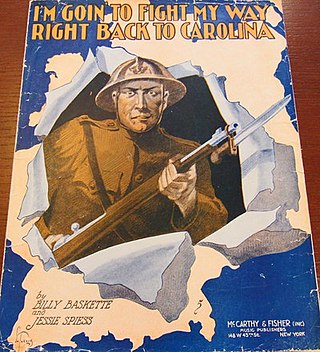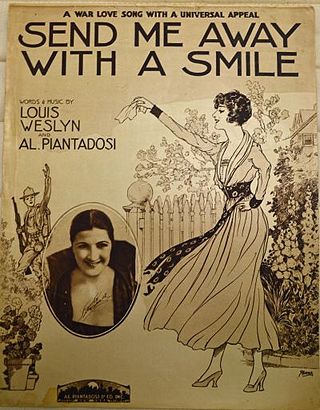Fred Fisher was a German-born American songwriter and Tin Pan Alley music publisher.

Alfred Bryan was a Canadian lyricist.

In the Land O' Yamo Yamo is a World War I song written in 1917. Joe McCarthy wrote the lyrics and Fred Fisher composed the music. McCarthy & Fisher, Inc. produced the song in New York, New York. On the cover of the sheet music is a man playing the guitar as a woman dances in the foreground. The lyrics describe a place that is not found on the map, but resembles "Old Napoli," referring to a city in Italy. "Yamo Yamo" is an English transliteration of the Neapolitan phrase "iammo, iammo", a dialectal reduction of "andiamo, andiamo" and the beginning of the chorus of the worldwide popular Italian song "Funiculì, Funiculà", which is mentioned in "Yamo Yamo"'s subtitle. "Yamo Yamo" is illustrated in the chorus as a place where the "good fellows are" and where "you can never hear them talk about the war." The song reached number two on the US song charts in May 1918.

"I'm Goin' To Fight My Way Right Back to Carolina" is a World War I era song written and composed by Billy Baskette and Jessie Spiess. The song was published in 1918 by McCarthy & Fisher, Inc. of New York City. The sheet music cover was designed by Andre C. De Takacs. It features an armed soldier tearing through the cover. The song was written for both voice and piano.

"Lorraine " is a World War I era song released in 1917. Al Bryan wrote the lyrics. Fred Fisher composed the music. It was published by McCarthy and Fisher, Inc.. André De Takacs designed the sheet music cover. It features a French soldier with his bayonet drawn in the foreground. A woman, who is a symbol of Liberty, and child look on behind him. The song was written for voice and piano.

"And He'd Say, 'Oo-La-La! Wee-Wee!'" is a World War I era song released in 1919. Lyrics and music were written by George Jessel and Harry Ruby. William Baker arranged the song. It was published by Waterson, Berlin & Snyder, Inc. of New York, New York. The song was written for voice and piano.

"Allegiance: Patriotic Song" is a World War I song first copyrighted on March 14, 1918.
"We're Going Over the Top" is a World War I song written by Andrew B. Sterling, Bernie Grossman, and Arthur Lange. It was published in 1917 by Joe Morris Music Co., in New York, NY. The sheet music cover, designed by Starmer, illustrates a battlefield scene with a tank moving over the top of a trench and soldiers inside the trench getting out of the way of the tank. Behind the tank soldiers march up the field.

"The Dream of a Soldier Boy" is a World War I song written by Al Dubin and composed by James V. Monaco. It was published in 1917 by Witmark & Sons in New York City. The sheet music cover depicts a photo of a soldier embracing his mother while a proud father and others look on.

"Oh! Frenchy" is a World War I song written by Sam Ehrlich and composed by Con Conrad. It was published in New York, New York by Broadway Music corporation in 1918. The song was in the top 20 charts from September 1918 to March 1919 and was number 2 in October, December, and February. The sheet music cover features a soldier pictured in uniform with a woman in his heart.
"Lafayette " is a World War I song written and composed by Mary Earl, which was a pseudonym of Robert A. King. It was published in New York, New York by Shapiro, Bernstein, & Co. in 1918. The sheet music cover, illustrated by Albert Barbelle, depicts soldiers marching with fixed bayonets below a statue of Lafayette in silhouette.

"I'm Crazy Over Every Girl In France" is a World War I song written by Alfred Bryan and composed by Pete Wendling and Jack Wells. The song was published in 1917 by Waterson, Berlin, & Snyder Co., in New York, NY. The sheet music cover, illustrated by Barbelle, depicts a soldier standing against a sea wall with a woman on top of the wall, her arm on his shoulder watching another girl walking by and features battleships in the background.

"I'm Giving You To Uncle Sam" is a World War I song written by Thomas H. Ince and composed by Victor Schertzinger. The song was published in 1918 by Southern California Music in Los Angeles, CA. The sheet music cover depicts soldiers charging out of a trench with the US Capitol and a flag in the background.

"Giddy Giddap! Go On! Go On! We're On Our Way to War" is a World War I song written and composed by Jack Frost. This song was published in 1917 by Frank K. Root & Co., in Chicago, Illinois. The sheet music cover depicts a mule pulling four soldiers in a wagon.
"It Won't Be Long Before We're Home" is a World War I song in the style of a march. It was written by Paul Cunningham and composed by Joseph E. Howard. This song was published in 1918 by M. Witmark & Sons, in New York, NY.

"Mother, Here's Your Boy!" is a World War I song written and composed by Sidney D. Mitchell, Archie Gottler, and Theodore Morse. This song was published in 1918 by Leo. Feist, Inc., in New York, NY. The sheet music cover depicts Uncle Sam presenting a returning soldier to his mother with the Statue of Liberty and ships in the background.

Send Me Away With A Smile is a World War I song written by Louis Weslyn and composed by Al Piantadosi. The song was first published in 1917 by Al. Piantadosi & Co., Inc. in New York, NY. The sheet music cover depicts a woman waving to a soldier from a fenced yard with an inset photo of Rita Gould.
When I Come Back To You is a World War I song written and composed by William Tracey and Jack Stern. The song was first published in 1918 by Douglas & Newman Music in New York, NY.The sheet music cover depicts a soldier hugging a woman with the Liberty Bell in the background.
"Welcome Home" is a World War I song written by Bud Green and composed by Edward G. Nelson. The song was first published in 1918 by A.J. Stasny Music Co., in New York, NY. The sheet music cover depicts soldiers being welcomed home by men and women.
When the Flowers Bloom On No-Man's Land is a World War I song written by Howard E. Rogers and composed by Archie Gottler. The song was first published in 1918 by Kalmar, Puck, & Abrahams Music Co., in New York, NY. The sheet music cover depicts soldiers marching with an inset photo of Fred Weber. The sheet music was later reprinted with an inset photo of Dorothy Jarrett.













